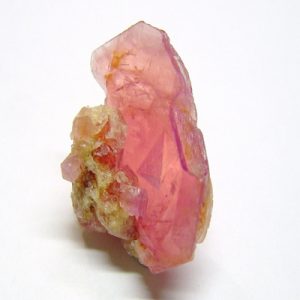Pezzottaite (Beryl)
Pezzottaite is a rich, pinkish-red mineral that was discovered in 2002 in Ambatovita, Fianarantsoa Province, Madagascar and was originally thought to be a new discovery of the rare mineral Red Beryl (Bixbite). The chemical formula of Pezzottaite of Cs(Be2Li)Al2Si6O18 and its molecular weight is 658.80 gm. But it was different from Red Beryl and was then thought to be a new type of Beryl and was called Cesium Beryl for its rich casium (Cs) content (about 15% caesium). The addition of casium and lithium to its chemical composition and the fact that Beryl crystallizes hexagonally while Pezzottaite crystallizes trigonally differentiates it from Beryl. Because of these differences, Pezzottaite was recently approved by the IMA as a new mineral species (IMA #2003-022) of the Beryl group of minerals. Pezzottaite is a very rare casium (Cs) analogue of Beryl. It is one of only two minerals that have caesium as an essential part of their chemistry – the other is Pollucite. Pezzottaite is typically moderately to heavily included and is also available as a Catseye.
Pezzottaite has recently been offered on the market by some sellers as Bixbite. Pezzottaite does resemble Bixbite in color and some mineral characteristics, and it is a member of the Beryl group of minerals, but it is not Bixbite. Pezzottaite has only been found in Ambatovita, Madagascar. The Wah Wah Mountains of Utah, USA is still the only location in the world to find gem quality Bixbite.
| Category: | Cyclosilicate minerals |
| Chemical Formula: | Cs(Be2Li)Al2Si6O18 |
| Molecular Weight: | 658.80 gm |
| Crystallography: | Trigonal – Ditrigonal Pyramidal |
| Crystal Habit: | Hexagonal tabular crystals, small flat to equant crystals |
| Twinning: | None |
| Cleavage: | [001] Imperfect |
| Fracture: | Irregular, Uneven, Conchoidal |
| Tenacity: | Brittle |
| Hardness (Mohs): | 8.0 |
| Density: | 2.97 (g/cm3) |
| Luminescence: | None |
| Radioactivity: | Barely Detectable, GRapi = 212.96 (Gamma Ray American Petroleum Institute Units) |
| Color: | Raspberry Red, Pink |
| Transparency: | Transparent to Translucent |
| Luster: | Vitreous (glassy) |
| Refractive Index: | 1.601 – 1.620 Uniaxial ( – ) |
| Birefringence: | 0.0090 – 0.0110 |
| Dispersion: | 0.014 (low) |
| Pleochroism: | Strong; orange-red to purple-violet |


